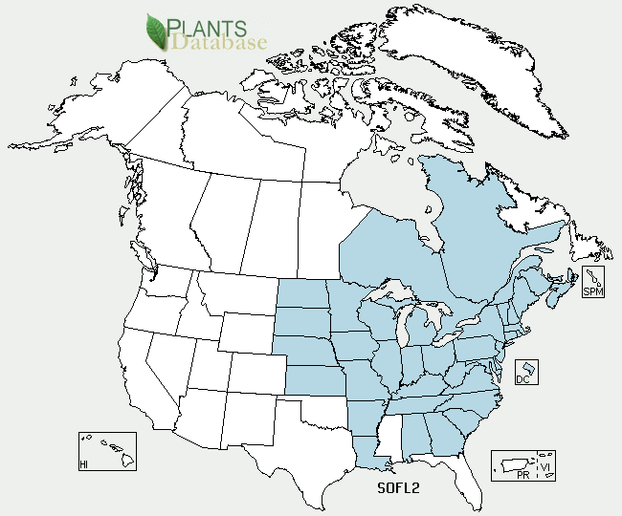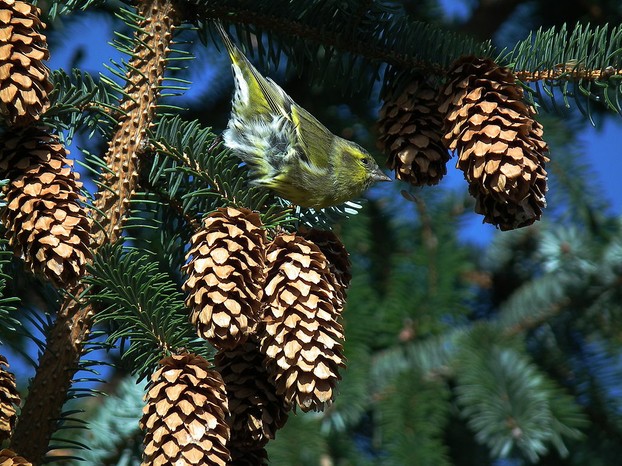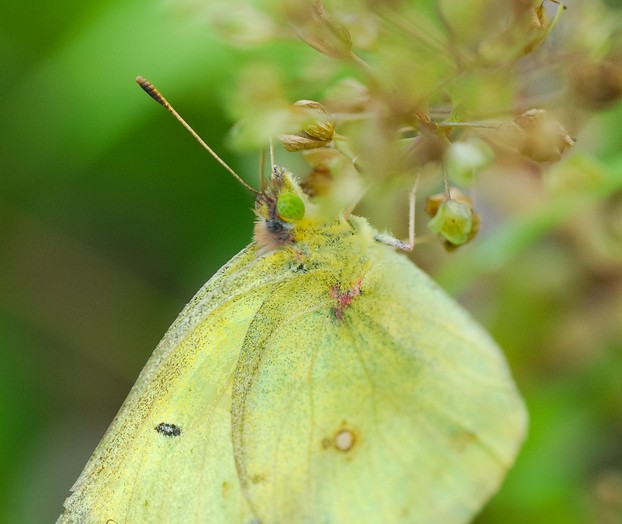Blanchan, Neltje. Wild Flowers Worth Knowing. Adapted by Asa Don Dickinson from Nature's Garden. Little Nature Library. Garden City, NY: Doubleday, Page & Company, 1917.
- Available via HathiTrust at: http://catalog.hathitrust.org/Record/008594789
- Available via Project Gutenberg at: http://www.gutenberg.org/files/8866/8866-h/8866-h.htm
Britton, Nathaniel Lord, and Addison Brown. An Illustrated Flora of the Northern United States, Canada, and the British Possessions, from Newfoundland to the parallel of the Southern Boundary of Virginia, and from the Atlantic Ocean Westward to the 102d Meridian. Volume III: Gentianaceae to Compositae Gentian to Thistle. 2nd ed. New York: Charles Scribner’s Sons, 1913.
- Available via Biodiversity Heritage Library at: http://www.biodiversitylibrary.org/item/15708
Champlin, Richard L. "Lawton's Valley Revisited." The Rhode Island Wild Plant Society Newsletter, Vol. 7 #1 (March 1993): 1-2.
- Available at: http://www.riwps.org/newsletter-07-01.pdf
"Clouded Sulphur Colias philodice (Godart, 1819)." Butterflies and Moths of North America. Butterfly and Moth Information Network, Kelly Lotts and Thomas Naberhaus. Web. www.butterfliesandmoths.org
- Available at: http://www.butterfliesandmoths.org/species/Colias-philodice
"Eastern Tailed-Blue Cupido comyntas (Godart, [1824])." Butterflies and Moths of North America. Butterfly and Moth Information Network, Kelly Lotts and Thomas Naberhaus. Web. www.butterfliesandmoths.org
- Available at: http://www.butterfliesandmoths.org/species/Cupido-comyntas
Flora: A Gardener’s Encyclopedia. Volume II: L-Z. Portland OR: Timber Press, 2003.
“Gardens 2 Go.” Nith River Native Plants. Web. nithriverplants.com
- Available at: http://nithriverplants.com/gardens2go.html
“Golden Rod.” Hamilton > Academics > College Seminar 235: Food for Thought "The 1812 Garden" > Our Research. The Trustees of Hamilton College. Web. academics.hamilton.edu
- Available at: http://academics.hamilton.edu/foodforthought/Our_Research_files/goldenrod.pdf
"Gray Hairstreak Strymon melinus (Hübner, 1818)." Butterflies and Moths of North America. Butterfly and Moth Information Network, Kelly Lotts and Thomas Naberhaus. Web. www.butterfliesandmoths.org
- Available at: http://www.butterfliesandmoths.org/species/Strymon-melinus
Holm, Heather. "Caterpillars and Their Look Alikes." Restoring the Landscape with Native Plants. Monday, August 30, 2010. Heather Holm. Web. www.restoringthelandscape.com
- Available at: http://www.restoringthelandscape.com/2010/08/caterpillars-and-their-look-alikes.html
Holm, Heather. "Native Plant of the Week: Zigzag Goldenrod ~ Solidago flexicaulis." Restoring the Landscape with Native Plants. Friday, September 23, 2011. Heather Holm. Web. www.restoringthelandscape.com
- Available at: http://www.restoringthelandscape.com/2011/09/native-plant-of-week-zigzaggoldenrod.html
House, Homer Doliver. Wild Flowers of New York. Part 2. Albany NY: University of the State of New York, 1918.
- Available via Biodiversity Heritage Library at: http://www.biodiversitylibrary.org/item/62995
Linnaei, Caroli. "7. Solidago flexicaulis." Species Plantarum, Exhibentes Plantas Rite Cognitas, ad Genera Relatas, Cum Differentiis Specificis, Nominibus Trivialibus, Synonymis Selectis, Locis Natalibus, Secundum Systema Sexuale Digestas. Tomus II: 879. Holmiae: Laurentii Salvii, 1753.
- Available via Biodiversity Heritage Library at: https://www.biodiversitylibrary.org/page/358900
"Milbert's Tortoiseshell Aglais milberti (Godart, 1819)." Butterflies and Moths of North America. Butterfly and Moth Information Network, Kelly Lotts and Thomas Naberhaus. Web. www.butterfliesandmoths.org
- Available at: http://www.butterfliesandmoths.org/species/Aglais-milberti
Moerman, Daniel E. Native American Ethnobotany. Portland OR: Timber Press, 1998.
Moerman, Daniel. Native American Medicinal Plants: An Ethnobotanical Dictionary. Portland OR: Timber Press, 2009.
Ortho's All About Attracting Hummingbirds and Butterflies. Des Moines IA: Meredith Books, 2001.
Mohlenbrock, Robert H. "Zigzag Goldenrod Solidago flexicaulis L." Midwestern Wetland Flora: Field Office Guide to Plant Species. Lincoln NE: USDA Soil Conservation Service (SCS) Midwest National Technical Center, 1989.
- Available via Biodiversity Heritage Library @ https://www.biodiversitylibrary.org/page/47569053
"Pearl Crescent Phyciodes tharos (Drury, 1773)." Butterflies and Moths of North America. Butterfly and Moth Information Network, Kelly Lotts and Thomas Naberhaus. Web. www.butterfliesandmoths.org
- Available at: http://www.butterfliesandmoths.org/species/Phyciodes-tharos
"Purplish Copper Lycaena helloides (Boisduval, 1852)." Butterflies and Moths of North America. Butterfly and Moth Information Network, Kelly Lotts and Thomas Naberhaus. Web. www.butterfliesandmoths.org
- Available at: http://www.butterfliesandmoths.org/species/Lycaena-helloides
Putnam, Patti, and Milt Putnam. North America’s Favorite Butterflies: A Pictorial Guide. Minocqua WI: Willow Creek Press, 1997.
Rhode Island Department of Environmental Management. "2015 Rhode Island Wildlife Action Plan: Appendices 1a, 1b, 1c, 1d, 1e, 1f." Rhode Island Department of Environmental Management (DEM) > Offices & Divisions > Fish & Wildlife > Wildlife & Hunter Education.
- Available at: http://www.dem.ri.gov/programs/bnatres/fishwild/swap/RIWAP-Appendix1a-f.pdf
Rhode Island Department of Environmental Management. "Appendices 1a, 1b, 1c, 1d, 1e, 1f: September 2005 Comprehensive Wildlife Conservation Strategy."
- Available at: http://www.dem.ri.gov/programs/bnatres/fishwild/swap/app1draft.pdf
Rhode Island Department of Environmental Management. "Rhode Island’s Comprehensive Wildlife Conservation Strategy September 2005." Rhode Island Department of Environmental Management (DEM) > RIDEM Programs, Offices & Divisions > Natural Resources Bureau > Fish & Wildlife.
- Available at: http://www.dem.ri.gov/programs/bnatres/fishwild/pdf/swgplan.pdf
"Rhode Island Wildlife Action Plan (RI WAP)." Rhode Island Department of Environmental Management (DEM) > Offices & Divisions > Fish & Wildlife > Wildlife & Hunter Education.
- Available at: http://www.dem.ri.gov/programs/fish-wildlife/wildlifehuntered/swap15.php
Roth, Sally. Attracting Butterflies & Hummingbirds to Your Backyard. Rodale Organic Gardening Book. Emmaus PA: Rodale, 2001.
Slattery, Britt E., Kathryn Reshetiloff, and Susan M. Zwicker. Native Plants for Wildlife Habitat and Conservation Landscaping: Chesapeake Bay Watershed. Annapolis MD: U.S. Fish & Wildlife Service, Chesapeake Bay Field Office, 2003.
“Solidago flexicaulis L.” The Plant List > Angiosperms (Flowering Plants) > Compositae > Solidago. The Plant List: A Working List of all Plant Species. Royal Botanic Gardens, Kew and Missouri Botanical Garden. The Plant List (2010). Version 1. Web. www.theplantlist.org/
- Available at: http://www.theplantlist.org/tpl/record/gcc-127020
Tal, Arieh. “Solidago flexicaulis (Zigzag Goldenrod).” Nature Through the Lens > Gallery > Asters & Goldenrods of New England > Goldenrods. 01/01/2010. Arieh Tal. Web. www.nttlphoto.com
- Available at: http://www.nttlphoto.com/botany/astersgoldenrods/Goldenrods/Solidago/Flexicaulis/s_flexicaulis.htm
Tenaglia, Dan. "Solidago flexicaulis." Missouriplants.com > Yellow flowers, Leaves alternate. Last modified 02/08/2007. Dan Tenaglia. Web. www.missouriplants.com
- Available at: http://www.missouriplants.com/Yellowalt/Solidago_flexicaulis_page.html
U.S. Department of Agriculture Soil Conservation Service. Midwest Wetland Flora: Field Office Illustrated Guide to Plant Species. Lincoln NE: Midwest National Technical Center, 1989.
- Available via Biodiversity Heritage Library at: https://www.biodiversitylibrary.org/page/47568522































 Are Hawaiian Huakai Po Nightmarchers Avenging Halloween Thursday?on 10/02/2024
Are Hawaiian Huakai Po Nightmarchers Avenging Halloween Thursday?on 10/02/2024
 Mailing Addresses for 2023 Form 4868 Extending 1040 and 1040SR April 15, 2024, Due Dateon 04/15/2024
Mailing Addresses for 2023 Form 4868 Extending 1040 and 1040SR April 15, 2024, Due Dateon 04/15/2024
 Mailing Addresses for 2023 Forms 1040 and 1040SR Filed in 2024on 04/15/2024
Mailing Addresses for 2023 Forms 1040 and 1040SR Filed in 2024on 04/15/2024
 Mailing Addresses for 2022 Form 4868 Extending 1040 and 1040SR April 18, 2023, Due Dateon 04/13/2023
Mailing Addresses for 2022 Form 4868 Extending 1040 and 1040SR April 18, 2023, Due Dateon 04/13/2023



Comments
sandyspider, Goldenrod, like forsythia and spirea, is so welcoming with its bright, cheery, long-lasting yellow colors.
Do see a lot of the goldenrod plants in my area. Good information and how it zigzags.
cazort, Your encouraging comments about my tribute to zigzags, one of my favorite goldenrods, are greatly appreciated.
As with you, I also live in zigzag's native range. As you've noted, zigzags thrive in gardens as well as in the wild, under a variety of light conditions.
It's always a pleasure to meet up with zigzags. It's a treat that you're able to see zigzags growing along with blue wood asters. They make a stunning combination.
A similarly stunning blue-and-yellow contrast is zigzags with chicory. August is a wonderful month for their duet here.
This is an awesome page! I love how you highlight the ecological relationships between this plant and various animals. The butterflies that use this plant are beautiful!
I live in the native range of this plant, and have seen people grow zigzag goldenrod in gardens with great success, and I've also seen it growing in the wild. It seems extraordinarily shade-tolerant among goldenrods, and it's quite unique in terms of being one of the few yellow-blooming plants that blooms in late fall and can tolerate shade. I even saw one plant planted on a north-facing exposure which never got any direct sunlight, and it thrived and bloomed prolifically.
I also have seen it grown with heart-leaf aster, or blue wood aster, one of my favorite plants, and the blue-and-yellow color contrast is really beautiful, as the plants bloom at the same time, and they often grow well in similar conditions.
WriterArtist, Butterflies are so photogenic that, me, too, I love to look at their beautiful images. I've always enjoyed learning about butterflies, so it's a pleasure to share what I've learned from them.
Thank you for stopping by and expressing your appreciation of butterflies.
Wow - love these beautiful images of butterflies, you have quite an extensive information on them.